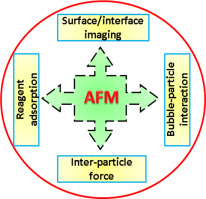Advances in Colloid and Interface Science ( IF 15.9 ) Pub Date : 2018-02-06 , DOI: 10.1016/j.cis.2018.01.004 Yaowen Xing , Mengdi Xu , Xiahui Gui , Yijun Cao , Bent Babel , Martin Rudolph , Stefan Weber , Michael Kappl , Hans-Jürgen Butt

|
During the past years, atomic force microscopy (AFM) has matured to an indispensable tool to characterize nanomaterials in colloid and interface science. For imaging, a sharp probe mounted near to the end of a cantilever scans over the sample surface providing a high resolution three-dimensional topographic image. In addition, the AFM tip can be used as a force sensor to detect local properties like adhesion, stiffness, charge etc. After the invention of the colloidal probe technique it has also become a major method to measure surface forces. In this review, we highlight the advances in the application of AFM in the field of mineral flotation, such as mineral morphology imaging, water at mineral surface, reagent adsorption, inter-particle force, and bubble-particle interaction. In the coming years, the complementary characterization of chemical composition such as using infrared spectroscopy and Raman spectroscopy for AFM topography imaging and the synchronous measurement of the force and distance involving deformable bubble as a force sensor will further assist the fundamental understanding of flotation mechanism.
中文翻译:

原子力显微镜在矿物浮选中的应用
在过去的几年中,原子力显微镜(AFM)已经发展成为在胶体和界面科学中表征纳米材料必不可少的工具。对于成像,安装在悬臂末端附近的尖锐探针在样品表面上进行扫描,可提供高分辨率的三维地形图。此外,AFM尖端还可以用作力传感器来检测局部性质,如附着力,刚度,电荷等。在胶体探针技术发明之后,它也已成为测量表面力的主要方法。在这篇综述中,我们重点介绍了原子力显微镜在矿物浮选领域中的应用进展,例如矿物形态成像,矿物表面水,试剂吸附等。,粒子间作用力和气泡-粒子相互作用。在未来几年中,化学成分的互补性表征(例如使用红外光谱和拉曼光谱进行AFM形貌成像以及同步测量涉及可变形气泡作为力传感器的力和距离)将进一步有助于对浮选机理的基本理解。











































 京公网安备 11010802027423号
京公网安备 11010802027423号